Digital Poster Session
Engineering: MR Engineering
Engineering
4219 -4233 MR Engineering - B0 Shimming
4234 -4249 MR Engineering - Gradient & Encoding Field Technology
4250 -4265 MR Engineering - Simulation in MR Design & Analysis
4266 -4281 MR Engineering - MR Engineering in Action 2
4282 -4296 MR Engineering - MR Engineering in Action 1
4219.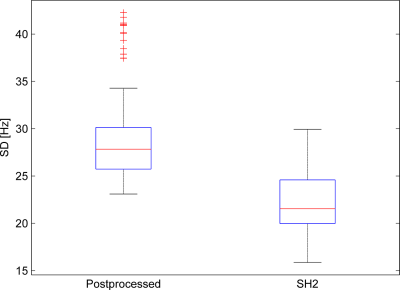 |
An open dataset of 126 human brain field maps
Hatem Elshatlawy1, Feng Jia1, Ali Aghaeifar2,3, Xiang Gao1, Sebastian Littin1, Huijun Yu1, Klaus Scheffler2,3, and Maxim Zaitsev1
1Dept.of Radiology, Medical Physics, Medical Center University of Freiburg, Faculty of Medicine, University of Freiburg, Freiburg, Germany, 2Max Planck Institute for Biological Cybernetics, Tuebingen, Germany, 3Department for Biomedical Magnetic Resonance, University of Tübingen, Tuebingen, Germany
126 human brain field maps from 18 normal subjects in 7 head positions each are published. The data may be of interest for shim coil designers as well as fro susceptibility mapping research.
|
|
4220.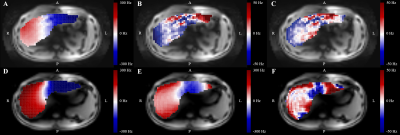 |
B0 shimming of the liver using a local shim coil array at ultra-high-field MRI
Lieke van den Wildenberg1, Quincy van Houtum1, Wybe van der Kemp1, Catalina Arteaga de Castro1, Alex Bhogal1, Paul Chang2, Sahar Nassirpour2, and Dennis Klomp1
1Radiology Department, UMC Utrecht, Utrecht, Netherlands, 2MR Shim GmbH, Reutlingen, Germany
Ultra-high-field MRI is more sensitive to variations in the B0 field specially for larger organs such as the liver. Dynamic shimming using a local array of shim coils can potentially improve the field homogeneity by 18-46% when compared to the standard hardware correction methods at 7T. The use of local shim coil arrays embedded in RF receiver coils may become a good strategy when maximizing shim performance considering the limited available number of shim channels, particularly for larger organs such as the liver at ultra- higher field strengths.
|
|
4221.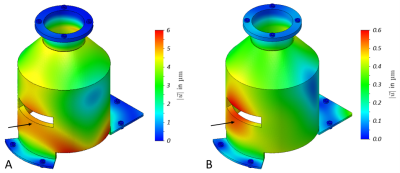 |
Finite Element Vibration Analysis of Multi-Coil B0 Hardware for Human Brain MRI
Sebastian Theilenberg1, Jalal Ghazouani1,2, and Christoph Juchem1,3
1Department of Biomedical Engineering, Columbia University in the City of New York, New York, NY, United States, 2Hamburg University of Technology, Hamburg, Germany, 3Department of Radiology, Columbia University in the City of New York, New York, NY, United States
As part of the design of a novel head-only scanner for improved accessibility of MRI and advanced motor coordination studies, we developed a finite element model of the expected vibration modes of a multi-coil array capable of generating linear and non-linear MRI encoding fields. We found significant resonances in the frequency range of interest whose shape and position can be altered by mechanical uncoupling of the array through mounting via rubber elements.
|
|
4222.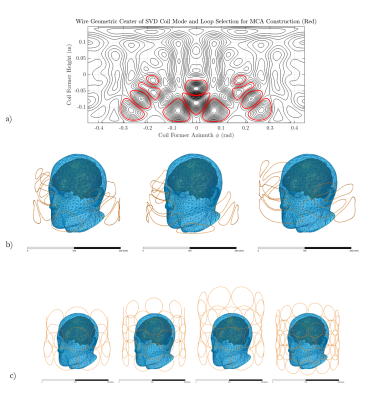 |
Human brain shimming performance comparison between matrix-like and stream-function SVD-based multi-coil arrays
Bruno Pinho Meneses1,2 and Alexis Amadon1
1Neurospin/CEA-Saclay, Gif-sur-Yvette, France, 2Université Paris-Saclay, Saclay, France
Last year we presented a novel whole-brain B0-shimming Multi-Coil Array design based on Stream Function Singular Value Decomposition on a cylindrical surface. Here this design is compared to more conventional single-layer matrix arrays in simulations based on a 100-subject B0-map database. While whole-brain shimming performance is naturally improved by our method, the effects of such optimization on slice-by-slice and region-specific shimming are not evident and are therefore explored in this work.
|
|
4223.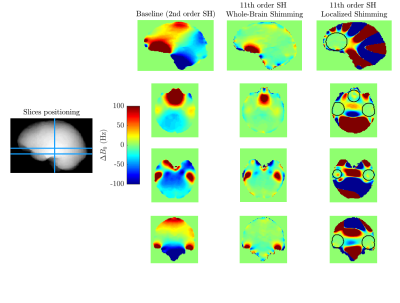 |
Analysis of B0 Field Shimming Limitations in the Human Brain at Ultra-High-Field
Bruno Pinho Meneses1,2 and Alexis Amadon1
1Neurospin/CEA-Saclay, Gif-sur-Yvette, France, 2Université Paris-Saclay, Saclay, France
Design of optimized shimming equipment is under way for UHF MRI of the human brain. Here shimming theoretical limits are explored. With a simple model, proof is given that, depending on field source distribution around a zone of interest, no shimming hardware external to such a zone can fully mitigate the inhomogeneous field. A simulation is performed on a 100-subject database to establish hard shim limits on the whole brain. On the other hand, 3D region-specific shimming is shown to be a very effective way to improve homogeneity in critical zones such as the pre-frontal cortex and around ear canals.
|
|
4224.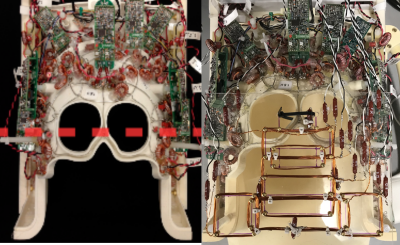 |
Computational Shim Coil Design Applied to Augmenting a Shim Array with a Non-Eye-Occluding Face Plate
Nicolas Arango1, Jason Stockmann2,3, Elfar Adalsteinsson1,4, and Jacob White1
1Department of Electrical Engineering and Computer Science, Massachusetts Institute of Technology, Cambridge, MA, United States, 2A. A. Martinos Center for Biomedical Imaging, Massachusetts General Hospital, Charlestown, MA, United States, 3Harvard Medical School, Boston, MA, United States, 4Institute for Medical Engineering and Science, Massachusetts Institute of Technology, Cambridge, MA, United States
Local multi coil shim arrays enable improved brain ΔB0 homogeneity shimming at low overall cost. We have developed tools for the computational design of additional local shim coils to augment existing shim arrays using sparse factorization techniques. A proof of concept seven channel face shim coil was designed and tested in vivo. This proof-of-concept shim coil shows promise for improving static field inhomogeneity in the pre-frontal cortex.
|
|
4225.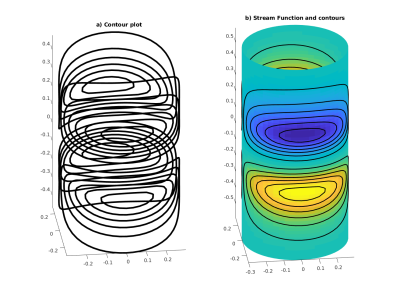 |
Of stream functions and thin wires: An open-source tool for intuitive gradient coil design
Sebastian Littin1, Feng Jia1, and Maxim Zaitsev1
1Department of Radiology, Medical Physics, University of Freiburg, University Medical Center, Freiburg, Germany
The design of gradient coils is sometimes perceived as complex. However, the relation between a current density and a stream function is a simple differentiation. Here we present an intuitive open source code collection to derive gradient coil designs from current densities. Stream functions are derived directly and indirectly from the current distribution. The aim of this work is to provide a simple tool for educational purposes. The code collection which is available on GitHub enables for straight-forward coil designs on simple surface geometries.
|
|
4226.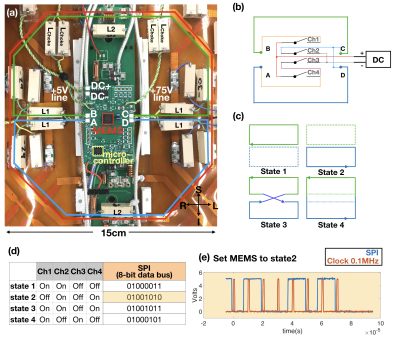 |
Adaptive iPRES Body Coil Array with Microelectromechanical System Switches for Simultaneous Imaging and Localized B0 Shimming
Yixin Ma1,2, Julia Bresticker1,2, Dean Darnell1,2, Fraser Robb3, Allen Song1,2, and Trong-Kha Truong1,2
1Brain Imaging and Analysis Center, Duke University, Durham, NC, United States, 2Medical Physics Graduate Program, Duke University, Durham, NC, United States, 3GE Healthcare, Aurora, OH, United States
The adaptive iPRES(N) coil design can effectively shim localized B0 inhomogeneities, while requiring one power supply per RF coil element and 4 MEMS switch packages to direct the DC current among the shim loops. Here, this design is improved by using only one 6-channel MEMS switch package per RF coil element and a SPI-interface to control all of them, which requires minimal space and a few command lines. In vivo experiments with an adaptive iPRES(2) body coil array demonstrated that it can reduce B0 inhomogeneities and EPI distortions more effectively than an iPRES(1) coil array, without requiring additional power supplies.
|
|
4227.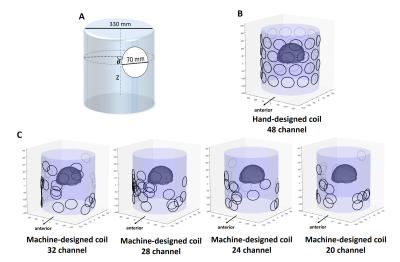 |
Machine designing: a multi-coil local shim design using Bayesian optimization
Chungseok Oh1, Eunjung Choi1, Woojin Jung1, Heong-geol Shin1, and Jongho Lee1
1Electrical and Computer Engineering, Seoul National University, Seoul, Republic of Korea
A multi-coil local shim has shown good performance on reducing B0 field inhomogeneity. However, the multi-coil local shim can be expensive due to a large number of channels. In this study, we developed a machine designing approach which uses the Bayesian optimization algorithm to determine the optimum locations of the multiple coils. In results, the machine-designed 28 channel coil local shim shows comparable performance to a hand-designed 48 channel coil local shim.
|
|
4228.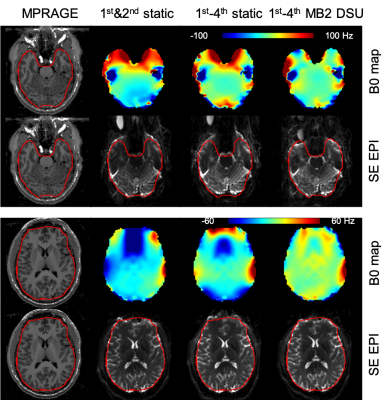 |
Dynamic Multiband Shimming and EPI at 7T
Chan Hong Moon1, Julie W. Pan1, and Hoby P. Hetherington1
1Radiology, University of Pittsburgh, Pittsburgh, PA, United States
At 7T, increased field strength and limited gradient performance results in increased geometric distortions for echo planar imaging. Use of higher order shims and dynamic updating on a slice by slice basis can dramatically reduce the extent of these distortions. This work describes: 1) the theoretical basis for the extension of slice by slice dynamic shim updating for multi-band acquisitions; 2) demonstrates that higher order spherical harmonic shim systems can intrinsically achieve MB=2 imaging with no loss in in-plane homogeneity in comparison to slice by slice shimming (MB=1), and 3) these improvements are easily visualizable in EPI.
|
|
4229.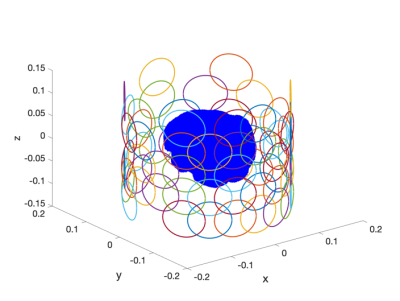 |
Optimization of Multi-Coil Array Design for Efficient Human Brain Shimming at 3T
Yubin Cai1, Hsin-Jung Yang1, Xinqi Li2, Tianshi Hu2, Yuheng Huang2, Yujie Shan2, Meng Lu1, Wai Shing Liu2, Debiao Li1, and Hui Han1
1Biomedical Imaging Research Institute, Cedars-Sinai Medical Center, Los Angeles, CA, United States, 2Cedars-Sinai Medical Center, Los Angeles, CA, United States |
|
4230.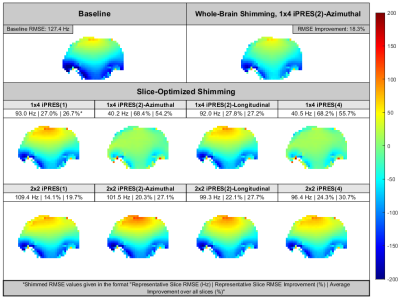 |
Numerical optimization of an iPRES coil design for high SNR and localized B0 shimming performance in small animal imaging
Zack Thompson1,2, Dean Darnell1,2, Darya Morozov3, Scott C Beeman3,4, Allen W Song1,2, and Trong-Kha Truong1,2
1Medical Physics Graduate Program, Duke University, Durham, NC, United States, 2Brain Imaging and Analysis Center, Duke University, Durham, NC, United States, 3Biomedical Magnetic Resonance Laboratory, Washington University in St. Louis, St. Louis, MO, United States, 4School of Biological and Health Systems Engineering, Arizona State University, Tempe, AZ, United States
Susceptibility-induced B0 inhomogeneities can cause distortions and signal loss, which are exacerbated in small animal imaging due to the typically higher field strength and smaller anatomy. Here, we further develop the integrated parallel reception, excitation, and shimming (iPRES) coil technology, which enables imaging and localized B0 shimming with a single RF/shim coil array, for small animal imaging. We start by numerically optimizing the design of a 4-channel iPRES rat coil array to achieve both a high B0 shimming performance (54.2% reduction in B0 root-mean-square error) and a high and uniform SNR over the brain.
|
|
4231.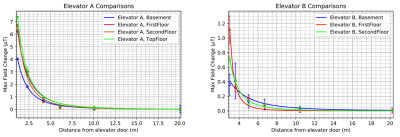 |
MRI Room Placement: The effect of an elevator operation on local magnetic environment
Diego F. Martinez1, Kieffer J. Davieau1,2, Eric J. Lessard1,2, William B. Handler1, and Blaine A. Chronik1,2
1The xMR Labs, Physics and Astronomy, Western University, London, ON, Canada, 2Medical Biophysics, Western University, London, ON, Canada
Developments in MR systems are allowing for siting which does not follow the typical “4 zone” architecture, removing barriers for MR implementation. A consequence of this is that these systems are nearer to elements of a building or hospital that may cause field distortions and cannot be resolved by shimming. This work quantifies the field distortions due to two typical elevators along a hallway and compares the distortion to a fit using a magnetic dipole approximation, verifying a 1/r3 field behaviour. This demonstrates the need for MR system placement guidelines which mitigate potential field stability concerns due to building elements.
|
|
4232.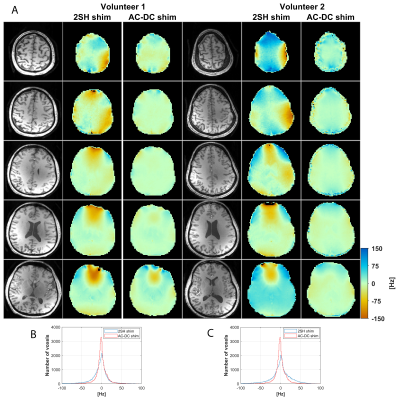 |
An Integrated RF-receive/B0-shim Array Coil Improves whole-brain MR Spectroscopic Imaging at 7T
Morteza Esmaeili1,2, Jason Stockmann1, Bernhard Strasser1, Zhe Wang3, Lawrence Wald1, and Ovidiu C. Andronesi1
1Athinoula A. Martinos Center for Biomedical Imaging, Department of Radiology, Massachusetts General Hospital, Harvard Medical School, Boston, MA, United States, 2Department of Diagnostic Imaging, Akershus University Hospital, Lørenskog, Norway, 3Siemens Medical Solutions, Charleston, MA, United States
An advanced local shimming technique can substantially improve magnetic resonance spectroscopic imaging (MRSI) which suffers from the inevitable local B0 inhomogeneities, particularly at ultra-high field. We evaluated the performance on an ultra-high field 7T MRI system of a custom-designed 32-channel head coil that with both RF-receive and DC-shim capability. Each coil loop simultaneously and independently runs AC and DC currents for RF-receive and B0-shimming. We examined the multi-coil shimming performance on five healthy volunteers using MRSI. The combined setup of DC-enabled local shimming and highly-efficient spectroscopic acquisition resulted in a noticeable improvement in the quality of spatial metabolic maps.
|
|
4233.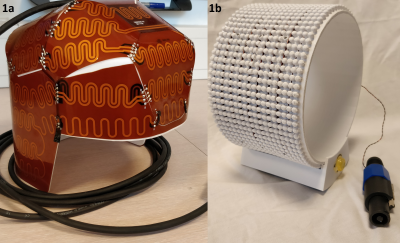 |
Understanding the axial crushing effects of numerous current paths at 7 Tesla
Erik Rutger Huijing1, Alexander Raaijmakers1,2, Dennis Klomp1, Jannie Wijnen1, and Alex Bhogal1
1Department of Radiology, University Medical Center Utrecht, Utrecht, Netherlands, 2Department of Biomedical Engineering, Eindhoven University of Technology, Eindhoven, Netherlands
MR spectroscopic images are often distorted by lipid signals in the skull. A crusher coil that generates a local magnetic field can suppress these signals, but a homogeneous crushing field is required. This work focusses on a solution for a homogeneous crushing field in the axial direction. It is shown through numerous tests with current patterns that wires circling the coil without any directioal component in the z-direction cause the most homogeneous crushing pattern. Currents in the z-direction should be compensated by a return current that cancels the magnetic field of the current.
|
4234.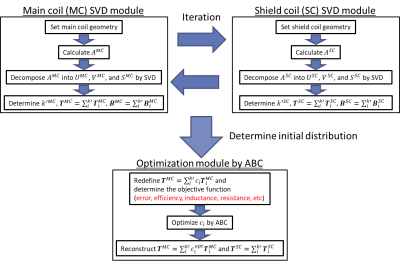 |
An automatic design method for arbitrary shaped shielded gradients using a singular value decomposition and meta-heuristic method
Kazuya Sakaguchi1 and Yasuhiko Terada1
1Institute of Applied Physics, University of Tsukuba, Tsukuba, Japan
Most of gradients coils are cylindrical or planar, but deformed gradients that fit an object shape should have superior performance. A truncated singular value decomposition (SVD) is a design method for arbitrary shaped gradients, but the design process is time-consuming, especially for shielded gradients. Moreover, coil performance, such as coil inductance and power dissipation cannot be optimized. In this study, we proposed a new strategy that combines the SVD method with a meta-heuristic method for automatically optimizing desired performance for shielded gradients.
|
|
4235.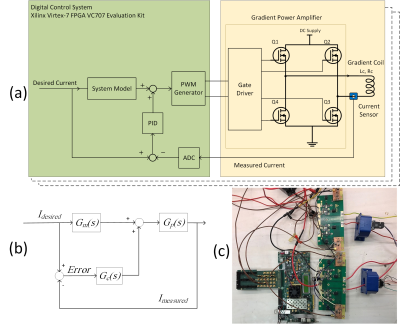 |
Digital Feedback Design for Mutual Coupling Compensation in Gradient Array System
Reza Babaloo1,2, Soheil Taraghinia1, Volkan Acikel3, Manoochehr Takrimi1, and Ergin Atalar1,2
1National Magnetic Resonance Resarch Center (UMRAM), Bilkent University, Ankara, Turkey, 2Department of Electrical and Electronics Engineering, Bilkent University, Ankara, Turkey, 3Aselsan, REHIS Power Amplifier Technologies, Ankara, Turkey
Gradient array systems can produce highly flexible spatial encoding magnetic fields. In the array structure, time fidelity of gradient current waveforms decreases due to high mutual coupling between gradient coils. Here we propose a closed-loop feedback in combination with feedforward to compensate for errors in the gradient current waveforms. A real-time digital PID controller is designed by considering the transfer function of the array system. The controller updates the applied voltage on the gradient coil by changing the duty cycle of pulse-width modulated (PWM) signals to decrease the error between desired and measured currents.
|
|
4236.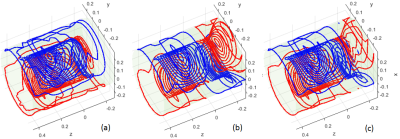 |
Analysis of Peripheral Nerve Stimulation in Asymmetric Non-folded and Folded Head Gradient Coil Design
Yihe Hua1, Desmond T.B. Yeo1, and Thomas K.F. Foo1
1GE Global Research, Niskayuna, NY, United States
Head-only gradient coil is not only more power efficient than the whole body system for high quality MR neuroimaging, but also reduces risk of peripheral nerve stimulation. In this abstract we compared two different head-only transverse gradient coil designs -- a non-folded design and a patient-end folded design, pointed out that the current turns on the connection region of the folded design that close to human body is more efficient to induce electric field and eddy current than the non-folded design in the neck, shoulder, chest and back. A connection-region turn-constrained folded coil design confirmed the observation.
|
|
4237.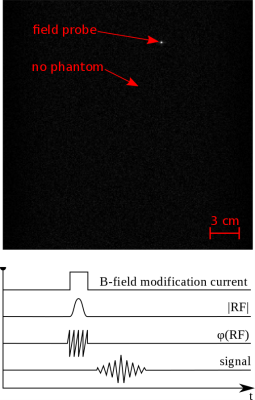 |
Off-resonant excitation of frequency-adjustable magnetic field probes
Niklas Wehkamp1, Philipp Rovedo1, Elmar Fischer1, Jürgen Hennig1, and Maxim Zaitsev1
1Radiology - Medical Physics, Medical Center - University Hospital Freiburg, Freiburg, Germany
Manipulating the Larmor frequency of a frequency-adjustable 1H field probe provides interesting new possibilities to excite and record the probe’s signal. Here, we present first proof-of-concept experiments that demonstrate the feasibility of selective off-resonant excitation of the probe. Free induction decays with the applied resonance offset current were recorded and characterized.
|
|
4238.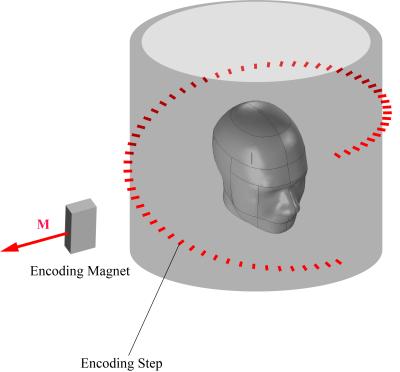 |
Characterization of a permanent magnet based 3D non-linear spatial encoding for ultra-low field MRI
Martin Sandrink1,2, Ruben Pellicer-Guridi1, Jiasheng Su1, Viktor Vegh1, and David C. Reutens1
1University of Queensland, Centre for Advanced Imaging, Brisbane, Australia, 2Departement of Engineering Physics, FH Muenster University of Applied Sciences, Muenster, Germany
The construction of a permanent magnet based 3D encoding system for an Ultra-Low field MR is presented and its initial characterization is presented. Proposed system moves a single permanent magnet along a prescribed helical path as proposed in our previous numerical study. This initial prototype is built to fit an existing ULF-MRI human extremity system. Preliminary results are in good agreement with the simulations. However, further studies are needed to identify the sources of error and improve the precision of the field estimations towards a practical encoding system.
|
|
4239.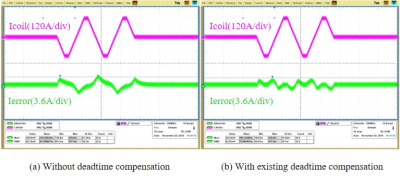 |
Adaptive Deadtime Compensation Control for MRI Gradient Amplifier
Huan Hu1, Juan A Sabate1, and Ruxi Wang2
1GE Global Research, Niskayuna, NY, United States, 2GE Aviation, Dayton, OH, United States
MRI gradient amplifier needs to provide current with extremely high fidelity to the commanded values of any arbitrary shape. Therefore, the control requires very accurate compensations of nonlinearities. One of the major sources is the deadtime among the power semiconductor devices. The existing deadtime compensation was to pre-test the specific system with different current commands and summarize a look-up table for use, which required lots of time and effort and cannot be used for different systems. This abstract demonstrates an adaptive deadtime compensation method which works well under different current commands and different systems without additional hardware cost.
|
|
4240.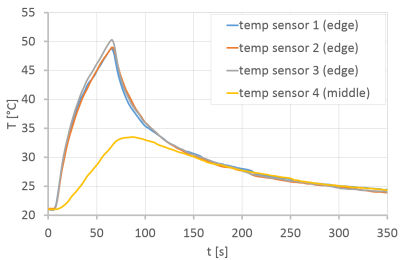 |
Gradient induced heating of components used in RF coil design
Manuela B. Rösler1, Roger Luechinger1, David O. Brunner1, Markus Weiger1, and Klaas P. Pruessmann1
1Institute for Biomedical Engineering, ETH Zurich and University of Zurich, Zurich, Switzerland
Gradient induced heating is relevant for RF coils used in recent high-performance gradient coils. In this abstract, we investigate the predictability of gradient induced heating on the basis of theoretical gradient field data. Furthermore, the heating of components usually used for coil construction e.g. different plugs, cables and shielding materials under intense gradient usage (EPI readout with 100 mT/m and 1200 mT/m/s at almost 100% duty cycle for 1 min) was measured. Depending on the position and orientation we observe temperature increases up to 67°C for an N-plug and 12°C for a coaxial cable.
|
|
4241.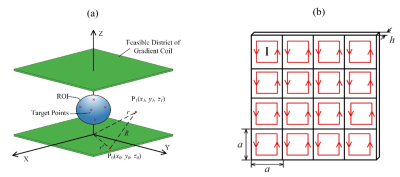 |
Gradient coil design and optimization with equivalent magnetic dipole method for ultra-low field MRI systems
Sheng Shen1,2, Zheng Xu1, Neha Koonjoo2,3,4, and Matthew S. Rosen2,3,4
1Chongqing University, Chongqing, China, 2MGH/A.A. Martinos Center for Biomedical Imaging, Cambridge, MA, United States, 3Department of Physics, Harvard University, Cambridge, MA, United States, 4Harvard Medical School, Boston, MA, United States
The gradient subsystem is an essential part of an MRI system. Figures of merit for these systems include slew rate and the gradient field linearity. Our previously described 6.5 mT ultra-low-field MRI scanner has marginal gradient performance with low slew rates (minimal rise time of 750µs) and low efficiency (around 10µT/m/A). We describe here the optimization of a new gradient coil system with improved slew rate and efficiency. We introduce the equivalent magnetic dipole method to design biplanar gradient coils, and our design study of the geometric parameters of the gradient coil (including the coil pattern, its size and density).
|
|
4242.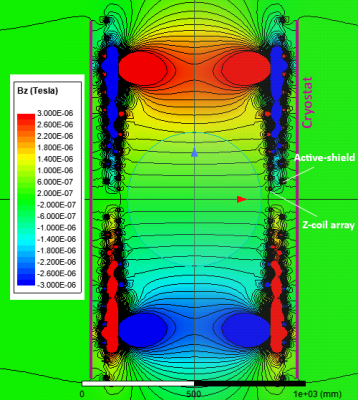 |
A Programmable Set of Z-Gradient Array and Active-Shield Array for Magnetic Resonance Imaging
Manouchehr Takrimi1 and Ergin Atalar1,2
1National Magnetic Resonance Research Center, Bilkent University, Ankara, Turkey, 2Department of Electrical and Electronics Engineering, Bilkent University, Ankara, Turkey
A novel programmable set of z-gradient array equipped with an active-shield array is introduced and simulated for diverse applications in magnetic resonance imaging (MRI). The proposed active-shield array can dynamically provide a proper shield for the main array in which its magnetic profile can be programmed based on the required scenario. This is achieved by using a set of independently tunable power amplifiers that feed both array elements individually or in a cluster. As a proof of concept, two sets of arrays are simulated: one for a double-gradient z-coil array and another one possessing a large field of view (FOV).
|
|
4243.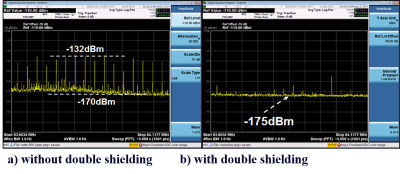 |
Radiated Noise Reduction for a Gradient Driver with SiC MOSFETs using Double Shielding
Juan Sabate1, Huan Hu1, Ruxi Wang2, and Logan Snow1
1GE Global Research, Niskayuna, NY, United States, 2GE Aviation, Dayton, OH, United States
The gradient driver was implemented with SiC MOSFETs. The amplifier has less losses and is more compact, however switching has higher high frequency contents. The new amplifier was tested in an EMI shielded room. The results show the effectiveness of the double shielding method at reducing the radiated noise generated by a gradient driver system. The tests confirmed the correlation between the conducted and radiated noise. The double shielding method proposed reduced the radiated noise caused by the CM circulating current between cables. The measurements showed up to 35dB radiated noise reduction with this method.
|
|
4244. |
Gradient design for a low-field Halbach array using the Target Field Method
Patrick Fuchs1, Bart de Vos1, Thomas O'Reilly2, Andrew Webb2, and Rob Remis1
1Circuits and Systems, Delft University of Technology, Delft, Netherlands, 2C.J. Gorter Center for High Field MRI, Leiden University Medical Center, Leiden, Netherlands
We describe the application of the target field method for designing three-axes gradients for the transverse magnetic field produced by a Halbach array, as well as verify this method by constructing a set of 3 gradient coils and using it for 3D imaging. Additionally an open-source tool is described which allows for easy gradient design using this method.
|
|
4245. |
Eddy Current Characterization of a Multi-Coil Array for Imaging in a Head-Only MR Scanner
Sebastian Theilenberg1, Ben John Parkinson2, and Christoph Juchem1,3
1Department of Biomedical Engineering, Columbia University in the City of New York, New York, NY, United States, 2Robinson Research Institute, Victoria University of Wellington, Wellington, New Zealand, 3Department of Radiology, Columbia University in the City of New York, New York, NY, United States
As part of a collaborative effort to create a novel compact high-temperature superconductor 1.5 T head-only scanner for improved accessibility of MRI and advanced motor coordination studies, we are developing a 31-coil Multi-Coil (MC) array for linear and non-linear image encoding and concomitant B0 shimming. Here we present a preliminary characterization of the expected eddy currents generated by the unshielded MC array in the unusual scanner assembly at hand based on finite element based electromagnetic simulations.
|
|
4246.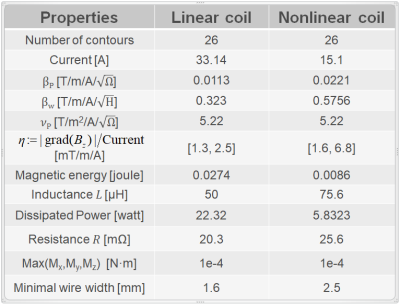 |
Design of a high-performance human-breast non-linear gradient coil for diffusion weighting
Feng Jia1, Sebastian Littin1, Philipp Amrein1, Huijun Yu1, Arthur Magill2, Tristan Kuder2, Sebastian Bickelhaupt3, Frederik Laun4, Mark E. Ladd2, and Maxim Zaitsev1
1Dept.of Radiology, Medical Physics, Medical Center University of Freiburg, Faculty of Medicine, University of Freiburg, Freiburg, Germany, 2Medical Physics in Radiology, German Cancer Research Center, Heidelberg, Germany, 3Junior Group Medical Imaging and Radiology – Cancer Prevention, German Cancer Research Center (DKFZ), Heidelberg, Germany, 4Department of Radiology, MR Physics, University Medical Center Erlangen, Erlangen, Germany
A nonlinear human-breast coil for diffusion weighting with a high performance 1T/m is designed.
|
|
4247.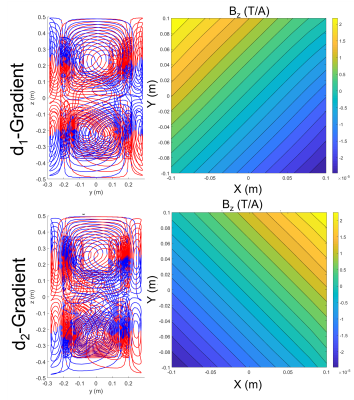 |
The X-Mode Gradient: Improved Performance for Select Applications
Eric J Lessard1,2, William B Handler2, and Blaine A Chronik1,2
1Department of Medical Biophysics, Western University, London, ON, Canada, 2Department of Physics, Western University, London, ON, Canada
In this work a design study of a shoulder cut-out gradient coil for use in a head-only MRI platform was performed. Specifically, based on previous work, it explored the effect of rotating the gradient axes on performance. This was due to the imbalance of gradient performance degradation due to the presence of cut-outs on conducting surfaces next to the patient's shoulders. This proof-of-concept exploration is the first demonstration of the feasibility of rotating the gradient axes during the design process to design a shoulder cut-out gradient coil.
|
|
4248. |
A Coil-Winding Machine for Wet-Winding of Resin-Impregnated Curved Wire Patterns
Yun Shang1, Sebastian Theilenberg1, Jalal Ghazouani1,2, and Christoph Juchem1,3
1Department of Biomedical Engineering, Columbia University, New York, NY, United States, 2Hamburg University of Technology, Hamburg, Germany, 3Department of Radiology, Columbia University, New York, NY, United States
The development of advanced Multi-Coil (MC) setups for the generation of MRI encoding fields necessitates the manufacture of wire wound coil fixated with epoxy resin. Common winding techniques, however, are not suitable for the required geometries. As a remedy, we developed an automated coil winding machine capable of winding coils with a large number of turns in irregular curved shapes whilst impregnating them with epoxy resin.
|
|
4249.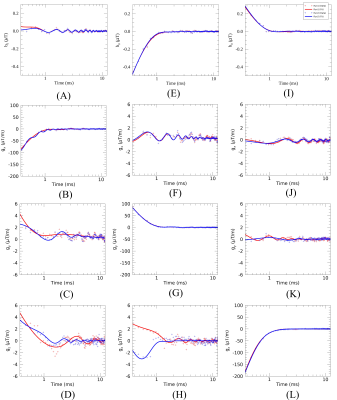 |
A novel gradient pattern for pre-emphasis
Magdoom Kulam Najmudeen1, Malisa Sarntinoranont2, and Thomas H Mareci2
1SQITS/NICHD, National Institute of Health, Bethesda, MD, United States, 2University of Florida, Gainesville, FL, United States
A new gradient pattern is introduced for performing pre-emphasis by uniform bandlimited excitation of eddy current and mechanical eigenmodes of the gradient system. The presented pattern is shown to be more effective in eliciting the gradient response than the energy equivalent trapezoidal pulse. This approach may allow the design of gradient waveforms that reduce artifacts in PFG experiments, e.g. measuring very slow diffusion and flow.
|
4250.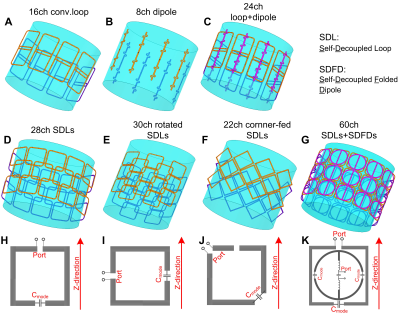 |
Investigation of Various Self-Decoupled Body Coil Arrays at Ultrahigh Fields
Ming Lu1,2,3, William A. Grissom1,2,4, John C. Gore1,2,4, and Xinqiang Yan1,2
1Vanderbilt University Institute of Imaging Science, Nashville, TN, United States, 2Department of Radiology, Vanderbilt University Medical Center, Nashville, TN, United States, 3College of Nuclear Equipment and Nuclear Engineering, Yantai University, Yantai, China, 4Department of Biomedical Engineering, Vanderbilt University, Nashville, TN, United States
At ultrahigh fields, to achieve ultimate receive performance, the optimal current patterns go beyond the uniform current of loops. A dipole-like current is desired and can be realized by directly adding dipole antennas or by inducing dipole-mode in loops. In this work, we investigated the receive performance of different kinds of arrays with self-decoupled loops (SDLs) or/and self-decoupled folded dipoles (SDFDs). These coils have dipole-like as well as loop-like patterns and are highly isolated. We found that the combination of SDL and SDFD exhibits considerable improvement for both peripheral/central SNR and parallel imaging, even compared to mixed loop+dipole arrays.
|
|
4251.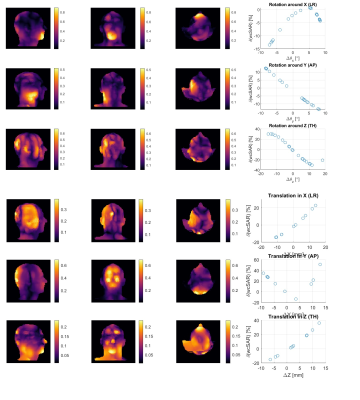 |
Positional Sensitivity of Specific Absorption Rate in Head at 7T
Amer Ajanovic1, Joseph V Hajnal1,2, and Shaihan Malik1,2
1Biomedical Engineering Department, School of Biomedical Engineering & Imaging Sciences, King's College London, London, United Kingdom, 2Centre for the Developing Brain, School of Biomedical Engineering & Imaging Sciences, King's College London, London, United Kingdom
One of the main problems at UHF resonance frequencies is the significant spatial variation in radiofrequency electromagnetic fields. Mitigating this problem has been one of the goals of the parallel transmission MRI, but it causes greater local SAR variability, which has led to more rigorous safety restrictions. We have used MARIE with an MRGF implementation to study position sensitivity of SAR estimation at 7T by performing multiple simulations in which the coil is moved with respect to the head. We observe higher positional variability in rotational perturbations than in translational ones with solutions obtained in 7.5 min per body-coil configuration.
|
|
4252.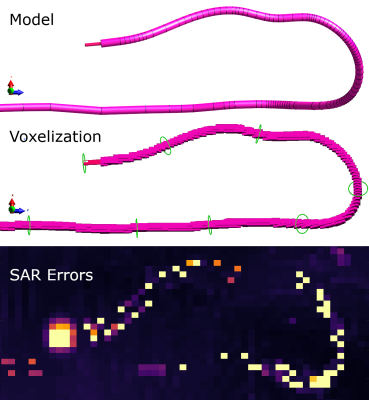 |
FDTD Simulation of embedded Elongated Conductors: Impact of Voxelization Errors and Model Simplification
J. Nuno Teixeira1, Shaihan Malik1,2, and Joseph V Hajnal1,2
1Biomedical Engineering Department, School of Biomedical Engineering & Imaging Sciences, King's College London, London, United Kingdom, 2Centre for the Developing Brain, School of Biomedical Engineering & Imaging Sciences, King's College London, London, United Kingdom
Several MRI scenarios can be studied by using electromagnetic simulation tools. The most common EM simulation software requires spatial discretization which can, for narrow objects like elongated conductors, become computationally heavy and time consuming. To avoid that, such objects are typically discretized suboptimally. Here, using FDTD simulations, we explore how these practices can often lead to errors which are not trivial to track and how simple changes in modelling can lead to significatively different results.
|
|
4253. |
RF-coil with variable resonant frequency for multiheteronuclear MRI
Viacheslav Ivanov1, Anna Hurshkainen1, Georgiy Solomakha1, and Mikhail Zubkov1
1Faculty of Physics and Engineering, ITMO University, Saint-Petersburg, Russian Federation
We propose a double-coil setup for broad-range heteronuclear MRI. The system designed for an 11.7T scanner comprises two independent coils, one of them tuned to 1H frequency to perform anatomical imaging, and another one, wire-array coil, tuned to the X-nucleus (including 2H, 11B, 13C, 23Na, 7Li and 31P) frequency. In order to tune the X-coil over such a wide range, both structural capacitance and inductance of the coil are made variable; narrow range tuning of the 1H coil is achieved via conventional tuning-matching circuit. The design principle and setup tunability are investigated in simulations and experimentally.
|
|
4254. |
A novel radiofrequency (RF) coil using dipole with multi-radiating elements at 7T
Lei Guo1, Aurelien Destruel1, Mingyan Li1, Haiwei Chen1, Ewald Weber1, Feng Liu1, and Stuart Crozier1
1School of ITEE, The University of Queensland, Brisbane, Australia
At ultra-high field (UHF) MRI, dipole-based antennas have deeper field penetration but increased specific absorption rate (SAR) levels than loop-type coils. In this work, a novel RF coil is proposed based on layer-configured dipole and multiple radiating elements. The designed RF coil is compared with a conventional dipole antenna in electromagnetic simulations and it is observed that more than 30% SAR reduction can be achieved with improved B1+ efficiency.
|
|
4255. |
Design and simulation of a transmit coil system for human head and neck imaging at 5 T
Qiaoyan Chen1, Zidong Wei2, Nan Li1, Feng Du1, Qiang He2, Xiaoliang Zhang3, Dong Liang1, Xin Liu1, Hairong Zheng1, and Ye Li1
1Shenzhen Institutes of Advanced Technology, Chinese Academy of Sciences, Shenzhen, China, 2Shanghai United Imaging Healthcare, Shanghai, China, 3Department of Biomedical Engineering, State University of New York, Buffalo, NY, United States
To achieve high SNR and high contrast for human MRI, ultra-high field can be applied. Considering the safety issues and the inhomogeneity of images at high fields, we aim to build a 5 T whole body MRI system. Based on this system, a transmit coil system for human head and neck imaging is designed and simulated. This work shows the preliminary studies with B1+ field and SAR assessments at 5 T.
|
|
4256.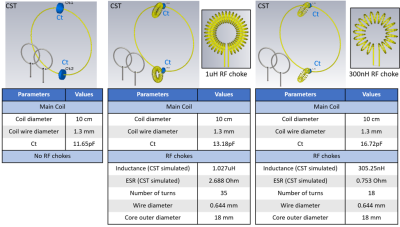 |
An Analytical Study of the effect of RF Chokes on Sensitivity Loss for 'iPRES' Coils at 3T
Yubin Cai1, John Stager1, Hsin-Jung Yang1, Debiao Li1, and Hui Han1
1Biomedical Imaging Research Institute, Cedars-Sinai Medical Center, Los Angeles, CA, United States |
|
4257.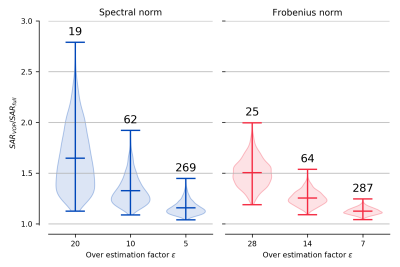 |
Virtual Observation Points calculated using Spectral and Frobenius Norms
Arthur W. Magill1
1Medical Physics in Radiology, German Cancer Research Center (DKFZ), Heidelberg, Germany
Virtual Observation Point (VOP) sets generated using the spectral and Frobenius norm are compared. It is found that while the spectral norm produces less VOPs for a certain over-estimation factor, the Frobenius norm actually produces more accurate VOPs. When compared in terms of sets containing (approximately) equal numbers of VOPs, the Frobenius norm performs better.
|
|
4258.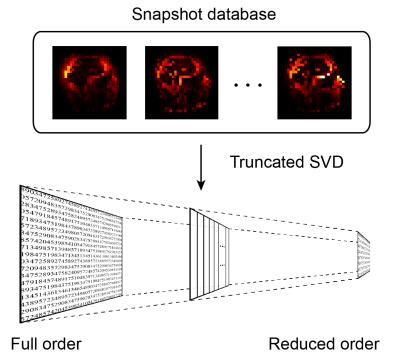 |
Efficient Local SAR Prediction based on Anatomical Differences and Model Order Reduction
Wyger Brink1, Jeroen van Gemert2, Andrew Webb1, and Rob Remis2
1C.J. Gorter Center for High Field MRI, dept. Radiology, Leiden University Medical Center, Leiden, Netherlands, 2Circuits and Systems, Delft University of Technology, Delft, Netherlands
An efficient approach to local SAR prediction is presented based on anatomical differences and model order reduction, which substantially reduces the memory footprint of this framework. The reduced order model can be solved using a direct inverse, which allows solving for the RF fields for multiple transmit channels simultaneously, which significantly improves the scalability in view of upcoming high field systems with an increasing number of RF transmit channels.
|
|
4259.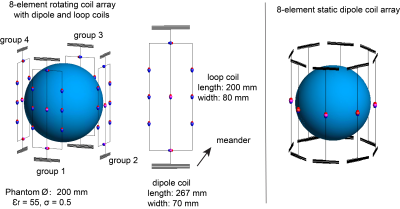 |
Eight-element Rotating Radiofrequency Coil Array with the Combination of Dipole and Loop Coils for Efficient B1 Shimming and SAR control at 7T
Mingyan Li1, Jin Jin1,2,3,4, Aurelien Destruel1, Lei Guo1, Ewald Weber1, Feng Liu1, and Stuart Crozier1
1School of Information Technology and Electrical Engineering, The University of Queensland, Brisbane, Australia, 2Siemens Healthineers, Brisbane, Australia, 34. Mark and Mary Stevens Neuroimaging and Informatics Institute, University of Southern California, Los Angeles, CA, United States, 4ARC Training Centre for Innovation in Biomedical Imaging Technology, The University of Queensland, Brisbane, Australia
An 8-element rotating radiofrequency coil array (RRFCA) consisting of loop and dipole pairs is proposed. By placing the dipole coil along the central axis of the loop coil, they are naturally decoupled due to the orthogonality of their polarised fields. Compared with a traditional 8-element static dipole coil array, the RRFCA is designed to provide better B1 shimming and SAR control performance benefited from the physical rotation. In addition, with eight coil elements, SNR will be improved compared to the previously developed 4-element RRFCA.
|
|
4260.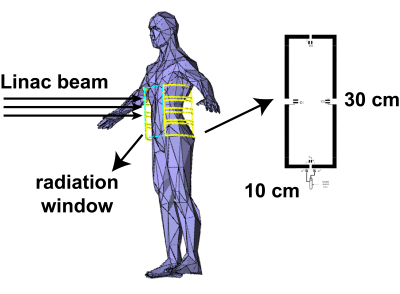 |
Theoretical Design and Image Reconstruction of an 8-element Receive-only Surface Coil Array for the 1.0 T Australian MRI-Linac System
Mingyan Li1, Ewald Weber1, Aurelien Destruel1, Feng Liu1, and Stuart Crozier1
1School of Information Technology and Electrical Engineering, The University of Queensland, Brisbane, Australia
The whole-body coil of the Australian MRI-Linac system can produce images without interfering with the Linac beam during radiotherapy. However, the whole-body coil is distant from the patient, causing lower SNR and is not parallel imaging capable. According to the radiotherapy treatment requirement, an 8-element surface coil array was designed to be radio-transparent and the corresponding imaging algorithms were developed for this coil array. The simulation results showed that the proposed coil array has improved SNR compared to the whole-body coil, and a reduction rate of three can be achieved in parallel imaging without prominent aliasing artefacts.
|
|
4261.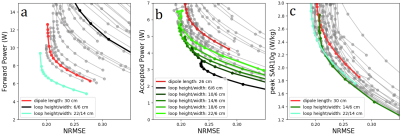 |
Design optimization of unshielded 8Tx transmit arrays for the head consisting of loops or dipoles at 7 Tesla
Carel Costijn van Leeuwen1, Cornelis A.T. van den Berg1, Dennis Klomp1, and Alexander J.E. Raaijmakers1,2
1Department of radiology, University Medical Center Utrecht, Utrecht, Netherlands, 2Eindhoven University of Technology, Eindhoven, Netherlands
Typical transmit arrays for the head use dipole or loop antennas within an RF shield. However, for certain applications an unshielded head coil array is required. This study explores different designs for unshielded head coil arrays using simulations. Using L-curves, the tradeoff which exists between power efficiency, homogeneity and SAR is evaluated for arrays consisting of loops and dipoles of various dimensions. Loops are found to be superior to dipoles. Small loops yield the highest power efficiency, while larger loops improve homogeneity and SAR efficiency.
|
|
4262.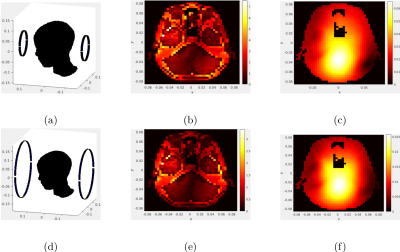 |
Rapid parametric optimization of transmit coil arrays: a proof-of-concept
Jose EC Serralles1, Elfar Adalsteinsson1, Lawrence L Wald2, and Luca Daniel1
1Electrical Engineering and Computer Science, Massachusetts Institute of Technology, Cambridge, MA, United States, 2A. A. Martinos Center for Biomedical Imaging, Massachusetts General Hospital, Charlestown, MA, United States
In this paper we efficiently combine a coil optimization process with an electromagnetic field solver and show preliminary proof of concept on simple systems leading to 22% to 45% improvement in Signal to Noise Ratios.
|
|
4263.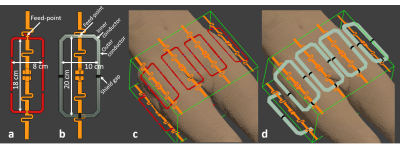 |
A 16-channel Combined Shielded-Loop-Resonator and Dipole Transceiver Array Design for Body Imaging at 7.0 Tesla
M. Arcan Erturk1, Russell L Lagore1, Gregor Adriany1, and Gregory J Metzger1
1Center for Magnetic Resonance Research, University of Minnesota, Minneapolis, MN, United States
A novel combined shielded-loop-resonator (SLR) and dipole antenna 16-channel transceiver body imaging array (16-SLR-D) is designed by combining eight pairs of dipole antennae and 10x20cm2 SLRs. Performance of the 16-SLR-D is compared against a 16-channel loop-dipole (16-L-D) array through finite-difference-time-domain simulations. Despite the larger loops size and closer placement of the elements, 16-SLR-D design has significantly improved coupling performance with less than 6% power coupled to other channels on average, compared to ~16% of average power coupling of 16-L-D. The combined SLR-dipole array(16-SLR-D) demonstrated ~+15% in transmit efficiency(mT/W0.5), ~+9% in transmit SAR efficiency (mT/SAR0.5) and ~+6% SNR inside the prostate.
|
|
4264.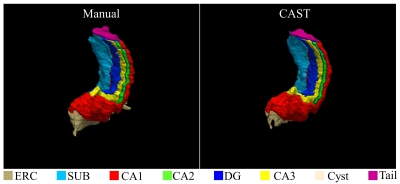 |
CAST: A multi-scale Convolutional neural network based Automated hippocampal subfield Segmentation Toolbox
Zhengshi Yang1, Xiaowei Zhuang1, Karthik Sreenivasan1, Virendra Mishra1, and Dietmar Cordes1,2
1Cleveland Clinic Lou Ruvo Center for Brain Health, Las Vegas, NV, United States, 2Department of Psychology and Neuroscience, University of Colorado, Boulder, CO, United States
The segmentation of human hippocampal subfields on in vivo MRI has gained great interest in the last decade, because these anatomic subregions were found to be highly specialized in recent studies and are potentially affected differentially by normal aging, Alzheimer’s disease, schizophrenia, epilepsy, major depressive disorder, and posttraumatic stress disorder. However, manually segmenting hippocampal subfields is labor-intensive and time-consuming, which limits the study to a small sample size. We developed a multi-scale Convolutional neural network based Automated hippocampal subfield Segmentation Toolbox (CAST) for automated segmentation, which can be easily trained and output segmented images in one minute.
|
|
4265.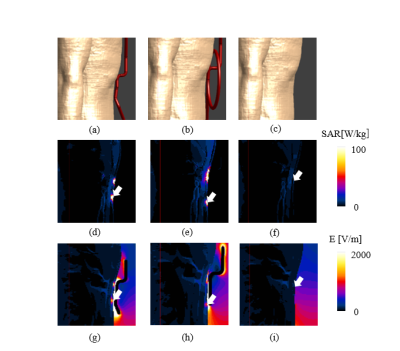 |
Electromagnetic simulation analysis of an RF burn injury due to an ECG lead
Kiyoi Okamoto1, Minghui Tang2, and Toru Yamamoto2
1Graduate School of Health Sciences, Hokkaido University, Sapporo, Japan, 2Faculty of Health Sciences, Hokkaido University, Sapporo, Japan
It is commonly believed that forming of a conductive loop in an MRI scanner is dangerous because a loop induces a large electric current by the RF excitation and causes RF burn injuries. To verify this belief, we modeled an RF burn injury case, which was caused by an ECG lead, on an electromagnetic analysis software, and simulated SAR and electric field. A large SAR that causes RF burns was confirmed with and without looping that induced small electric field not to cause RF burns. It was suggested that loop formation is not a major cause of RF heating.
|
4266. |
B1+ dependency on frequency in four human organs in three body models for 23Na, 13C and 31P whole-body birdcages at 7T.
Ria Forner1, Janot P. Tokaya2, Alexander Raaijmakers2,3, and Dennis Klomp2
1Radiology, UMC Utrecht, Utrecht, Netherlands, 2UMC Utrecht, Utrecht, Netherlands, 3Biomedical Engineering, Eindhoven University of Technology, Utrecht, Netherlands
This work is presenting a simulation study on X-nuclei imaging at 7T with a birdcage body coil for sodium, carbon and phosphorous. Three models and four imaging targets have been investigated. Although B1+ efficiency generally decreases with frequency, we show that the SAR efficiency, ( B1+/√SAR ) stays more or less constant over the investigated frequencies. Furthermore, it is shown that although every model and every imaging target has one optimal relative phase setting between the birdcage ports, for each frequency there exists one generic phase setting that provides only a minimal drop in performance over all imaging targets and models.
|
|
4267.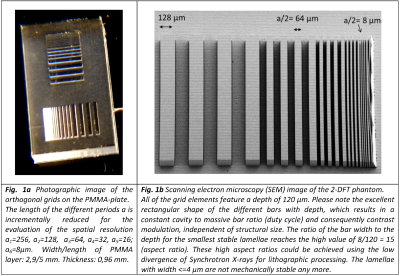 |
Quantification of microscopic spatial resolution on MR-scanners using micro-phantoms manufactured with Deep-Xray Lithography
Andreas Georg Berg1 and Martin Börner2
Poster Permission Withheld
1Center for Medical Physics and Biomedical Engineering, Medical University of Vienna, Vienna, Austria, 2Karlsruhe Nano Micro Facility (KNMF), Karlsruhe Institute of Technology (KIT), Eggenstein-Leopoldshafen, Germany
Quality control for systematic improvements in spatial resolution up to the microscopy range becomes increasingly relevant not only for preclinical imaging but also for High Field MR human scanners. The design, manufacturing technology, a prototype phantom and an exemplary evaluation for qualitative and quantitative measurement of the spatial resolution of MR-scanners claimed to offer spatial resolutions better than 100µm is presented. The spatial resolution for 2D-FT anisotropic imaging can be checked qualitatively and quantitatively by interpolation of the Modulation-Transfer-Function in two different spatial encoding directions at the same time with slice-thickness below 120µm up to 64 line-pairs/mm (pixel-size: 8µm).
|
|
| 4268. | WITHDRAWN | |
4269.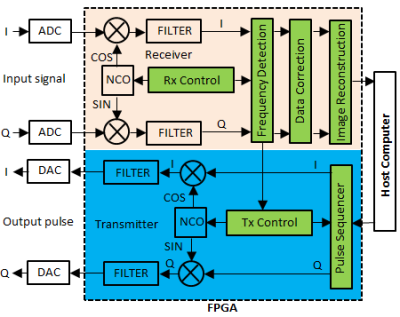 |
Development of a multifunctional digital transceiver suitable for real-time B0 field stabilization in MRI
Limin Li1 and Alice M. Wyrwicz1,2
Poster Permission Withheld
1Center for Basic MR Research, Northshore University HealthSystem, Evanston, IL, United States, 2Department of Biomedical Engineering, Northwestern University, Evanston, IL, United States
We report the early development of a multifunctional digital transceiver built on a Field-Programmable Gate Array (FPGA). The multifunctional transceiver not only offers the functionalities of a conventional transceiver and pulse sequencer, but also is capable of combining frequency detection and compensation, inline data correction and image reconstruction. We describe the design and implementation of the multifunctional transceiver and demonstrate its capabilities of image acquisition and reconstruction with real-time frequency and phase compensation.
|
|
4270.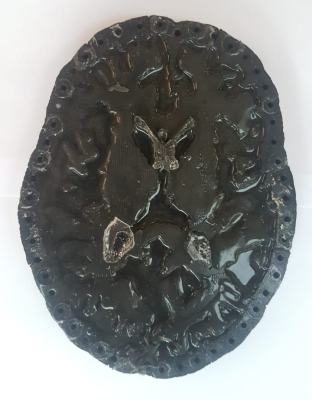 |
Realistic MRI phantom for T2 and Quantitative Susceptibility Mapping
Manuel Chapa1,2,3, Hernán Valenzuela4, Nestor Muñoz1,2,3, Mathias Lambert1,2,3, Marisleydis García1,2,3, Flavia Zacconi4, and Cristian Tejos1,2,3
1Biomedical Imaging Center, Pontificia Universidad Católica de Chile, Santiago, Chile, 2Millennium Nucleus for Cardiovascular Magnetic Resonance, Santiago, Chile, 3Department of Electrical Engineering, Pontificia Universidad Católica de Chile, Santiago, Chile, 4Faculty of Chemistry, Pontificia Universidad Católica de Chile, Santiago, Chile
In this work, we present a realistic phantom made of a solid material that we developed, which can mimic the human brain anatomy, including grey and white matter. Our new material also allows us to modulate T2 and susceptibility values by changing the ratios of a 4 component mix wich can result in T2 times from 100ms to 250ms and susceptibility values close to the human brain.
|
|
4271.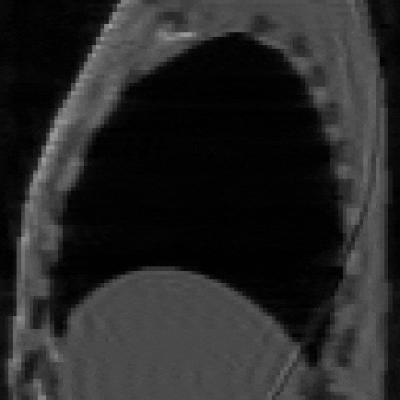 |
4D Deformable Digital Phantom for MRI Sequence Development
Hanna Maria Hanson1, Marcel van Herk1, David Cobben1,2, and Benjamin C Rowland1
1University of Manchester, Manchester, United Kingdom, 2The Christie NHS Trust, Manchester, United Kingdom
We present a digital phantom intended for MR-guided radiotherapy imaging sequence design and testing. The framework uses existing phantom generating software to provide the anatomical shape and movement, while the MRI simulation is handled by a modified version of a Bloch simulator. The accuracy of the phantom framework was demonstrated by simulating a 4D image of a single respiratory cycle and also by reproducing motion-related artefacts in a 2D image.
|
|
4272.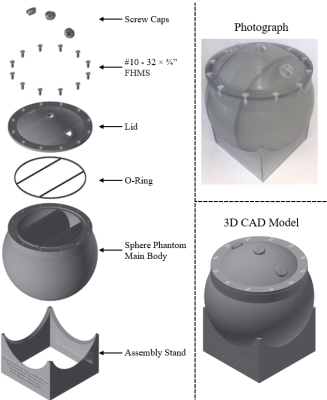 |
Development of a Three-Compartment Spherical CEST and T1 Phantom for UHF Sequence Development and Testing
Ryan T Oglesby1,2, Wendy Oakden2, Wilfred W Lam2, Agata Chudzik3, Katarzyna Kochalska3, Radoslaw Rola3, and Greg J Stanisz1,2,3
1Medical Biophysics, University of Toronto, Toronto, ON, Canada, 2Sunnybrook Research Institute, Toronto, ON, Canada, 3Neurosurgery and Paediatric Neurosurgery, Medical University of Lublin, Lublin, Poland
The development of quantitative MRI sequences at ultra-high field (UHF) (7 T or higher) is difficult due to non-uniform RF fields, enhanced susceptibility artifacts, and increased SAR. Phantoms are required in order to test quantitative pulse sequences, and it becomes increasingly important that artifacts in phantoms be as similar as possible to those observed in vivo. In this study, a 3D printed three-compartment spherical phantom was designed to evaluate chemical exchange saturation transfer (CEST), magnetization transfer (MT), and T1 mapping sequences on UHF MRI systems.
|
|
4273.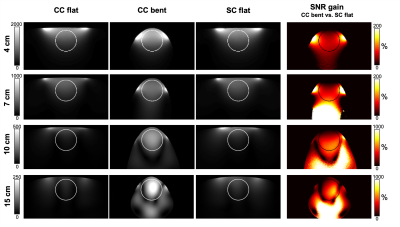 |
Flexible transmit/receive multi-gap coaxial coils for 7 T MRI
Lena Nohava1,2, Raphaela Czerny2, Michael Obermann1,2, Jacques Felblinger3, Roberta Frass-Kriegl2, Jean-Christophe Ginefri1, and Elmar Laistler2
1IR4M (Imagerie par Résonance Magnétique et Multi-Modalités), UMR8081, Université Paris-Sud/CNRS, Université Paris-Saclay, Orsay, France, 2Division MR Physics, Center for Medical Physics and Biomedical Engineering, Medical University of Vienna, Vienna, Austria, 3Université de Lorraine, Inserm, IADI, Nancy, France
We propose flexible multi-gap transmit/receive coaxial coils for 7 T MRI with 4, 7, 10 and 15 cm loop diameters, targeting different anatomies with large inter-subject variability and the need for close-fitting coil design. On the bench and in MRI, we evaluate the coaxial coils’ robustness upon bending, compare their performance to standard copper wire coils and demonstrate a significant SNR gain when using form-fitted coaxial coils instead of flat standard coils.
|
|
4274.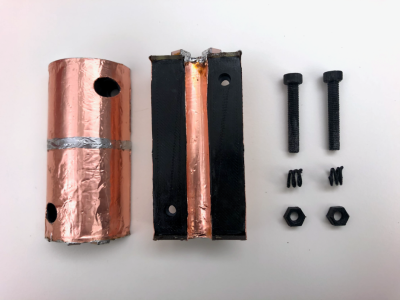 |
3D Printable, Floating Cable Trap
Jana Vincent1,2 and Joseph Rispoli1,3
1Weldon School of Biomedical Engineering, Purdue University, West Lafayette, IN, United States, 2Basic Medical Sciences, Purdue University, West Lafayette, IN, United States, 3School of Electrical & Computer Engineering, Purdue University, West Lafayette, IN, United States
Undesired common-mode currents traveling along the shield of cabling can affect radiofrequency coil performance and cause patient burns. Cable traps are necessary to suppress these common-mode currents in Magnetic Resonance environments. Floating cable traps, which allow for repositioning and reuse and eliminate the need to solder directly to cabling, have previously been reported as custom-manufactured apparatuses1. To streamline the manufacturing of floating cable traps and reduce manufacturing cost, we have designed 3D-printable versions that only require the addition of copper circuitry (e.g., tape/PCB) and lumped elements.
|
|
4275.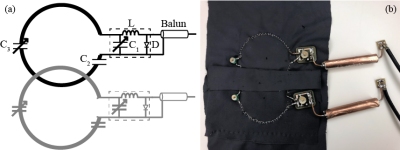 |
Two-Channel, Stretchable, and Flexible Breast Coil Array
Jana Vincent1,2 and Joseph Rispoli1,3
1Weldon School of Biomedical Engineering, Purdue University, West Lafayette, IN, United States, 2Basic Medical Sciences, Purdue University, West Lafayette, IN, United States, 3School of Electrical & Computer Engineering, Purdue University, West Lafayette, IN, United States
Given the decrease in mammography sensitivity for those with denser breast tissue, MRI is often utilized for supplemental screening. Here we present a stretchable, flexible, two-channel breast RF coil array that allows for a customized fit to the breast and closest possible positioning to the skin. This coil array was created by utilizing conductive thread, stitched onto polyester/spandex blend fabric. Clear images of both the phantom and in-vivo were obtained. Omnidirectional stretching provided increased patient comfort and customized fit. With this close proximity, greater sensitivity can be achieved when compared to traditional breast coils.
|
|
4276.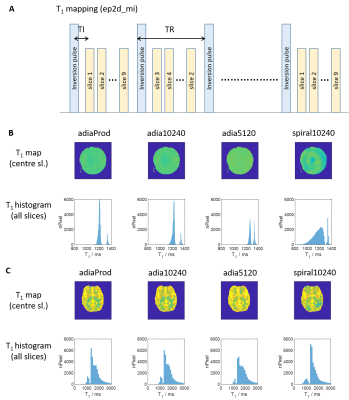 |
Investigation of pTx pulses for magnetisation inversion on 7T Terra
Belinda Ding1, Christopher Wickens1, Iulius Dragonu2, Catarina Rua1, Saba Shirvani1, Patrick Liebig3, Robin Heidemann3, Guy B Williams1, and Christopher T Rodgers1
1Wolfson Brain Imaging Centre, University of Cambridge, Cambridge, United Kingdom, 2Siemens Healthcare Limited, Firmley, United Kingdom, 3Siemens Healthcare Limited, Erlangen, Germany
We compare performance of two approaches for magnetisation inversion on a Siemens 7T Terra scanner, with 8Tx32Rx Nova head coil. We compared 3D non-selective pTx pulses designed in the scanner’s online pulse design tool, against traditional adiabatic pulses in both phantoms and the brain of a volunteer. We observe that spiral pTx pulses have substantially lower SAR burden than adiabatic hyperbolic secant pulses, but using the default parameter sets, the spiral inversion is less homogeneous. Thus, spiral pTx pulses are advantageous in SAR limited sequences, and further optimisation is likely to improve the inversion efficiency of these pulses.
|
|
4277.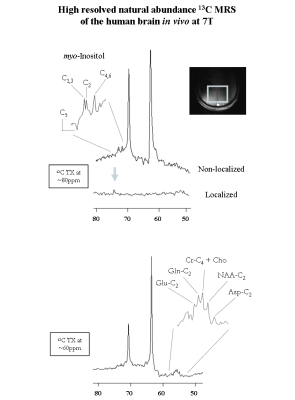 |
High resolved 13C MRS of myo-Inositol C1-C6 in the human brain in vivo at 7T
Eulalia Serés Roig1 and Rolf Gruetter1,2,3
Poster Permission Withheld
1Laboratory of Functional and Metabolic Imaging (LIFMET) - Ecole Polytechnique Fédérale de Lausanne (EPFL), Lausanne, Switzerland, 2Centre d'Imagerie BioMédicale - Animal and Imaging Technology (CIBM-AIT) - Ecole Polytechnique de Lausanne (EPFL), Lausanne, Switzerland, 3Department of Radiology, Universities of Lausanne (UNIL) and Geneva (UNIGE), Lausanne, Switzerland The quantification of metabolite signals in the 1H-spectrum of the human brain in vivo is complicated by an extensive spectral overlap of resonances, due to the restricted chemical shift dispersion of the 1H-nucleus. For instance, the myo-Inositol peaks observable in the 1H-spectrum at 7T are close the water resonance and overlap with that of glycine. In contrast, the high resolution of the 13C-MR spectrum aids in the interpretation of the highly sensitive but poorly resolved 1H-MR spectrum. In this study, we demonstrate the advantage of 13C-MRS at 7T by measuring high resolved myo-Inositol C1-C6 resonances in the human brain. |
|
4278.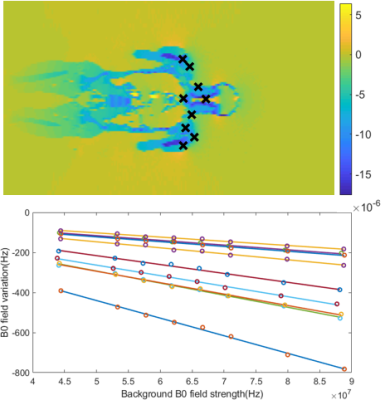 |
A Quantitative Analysis on Patient-induced B0 Field Inhomogeneity at 1.5T MRI System
Liyuan Jin1, Yaan Ge1, Qilin Lu1, Qingyu Dai1, and Kun Wang1
1GE Healthcare, Beijing, China
This abstract investigated the method for quantitatively predicting B0 variation induced by human body. Magnetic field simulation was performed, with human phantom positioned in different strength’s B0 fields, and revealed the linear relationship between patient-induced B0 inhomogeneity and the background B0 field. The linear relationship was proved in clinical experiment, which used the relationship to predict B0 field map and compared the predicted B0 field map with the real B0 field map. The clinical experiment shows that 95% voxels has a prediction accuracy within 50Hz. The finding could further benefit image quality and improve scan workflow.
|
|
4279.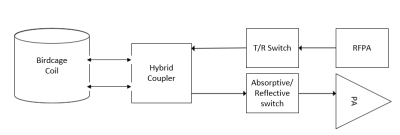 |
Analysis of the effects of Absorptive Switch v/s Reflective Switch on the performance of Hybrid Coupler designed for Birdcage coil at 1.5T MR System
Niraj Shalikram Yadav1, Miheer Pradeep Mayekar1, Rajesh Harsh1, and Vishal Dinesh Boricha1
1TID, Society For Applied Microwave Electronics Engineering & Research, Mumbai, India
Volume coils such as the Birdcage Coil possess homogeneous magnetic fields due to circularly polarized fields assisted by the Hybrid Coupler. To perform the complete operation of the birdcage coil for imaging, the Transmit power must be well isolated from the receive front end which is done by introducing RF switches in the receive path. However, Reflective switches cause impedance mismatch at the ports of the coupler. This work demonstrates an absorptive switch due to which the impedance mismatch problem is solved. Also, comparative analysis were done for both the type of RF switches.
|
|
4280. |
Miniaturized Quadrature Hybrid Coupler Using Coaxial Cable with Inductive Loading for 1.5T MRI System
Rohit Apurva1, Niraj Yadav1, Miheer Mayekar1, Bhaskara Naik1, Tapas Bhuiya1, and Rajesh Harsh1
1Technology Innovation Department, Society for Applied Microwave Electronics Engineering and Research, Mumbai, India
To improve the homogeneity of magnetic field and SNR of the Image by a factor of , quadrature feeding is required. For Quadrature Feeding, Hybrid coupler is an essential microwave circuit, but at RF range the size of hybrid coupler is large. To make it miniaturized and to overcome the problem of power handling capacity (compared to lumped element) we have proposed coaxial cable with inductive loading. This technique minimizes the size of hybrid by 75% and has a coupling of 3dB and phase difference of 900 at 63.87MHz.
|
|
4281.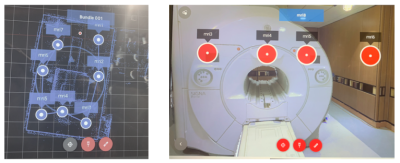 |
3D Surface Scanning an MRI Machine: Initial Experience and Preliminary Results
Nicole Wake1,2, Maggie Fung3, Stephen Dashnaw4, J. Thomas Vaughan Jr.4, and Fraser Robb5
1Department of Radiology, Montefiore Medical Center, Albert Einstein College of Medicine, Bronx, NY, United States, 2Center for Advanced Imaging Innovation and Research, Department of Radiology, NYU School of Medicine, New York, NY, United States, 3GE Healthcare, New York, NY, United States, 4Columbia University, New York, NY, United States, 5GE Healthcare, Aurora, OH, United States
An approach to 3D capture a life-sized MRI machine using 3D surface scanning is described. The 3D files generated can be used for 3D printing, augmented or virtual reality, or simulation studies.
|
4282.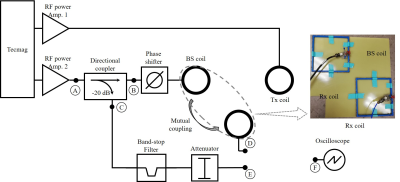 |
Design and comparison of the RF systems for frequency encoding by nonlinear Bloch-Siegert shift at low field MRI
Yonghyun Ha1, Kartiga Selvaganesan1, Baosong Wu1, Charles Rogers III1, Sajad Hosseinnezhadian1, Gigi Galiana1, and R. Todd Constable1
1Department of Radiology and Biomedical Imaging, Yale School of Medicine, New Haven, CT, United States
To achieve frequency encoding using Bloch-Siegert shift, the off-resonance pulse and signal reception would need to take place simultaneously. In this work we describe two methods to get rid of applied off-resonance signal from the receive signal. Both Tx cancelling and RF filter methods can be integrated into the RF chain to reduce the power of the off-resonance signal. It was found that using an RF filter was more effective for both blocking off-resonance signal and keeping receive signal. It was also demonstrated that the combination of two methods is promising in terms of reducing the off-resonance signal.
|
|
4283.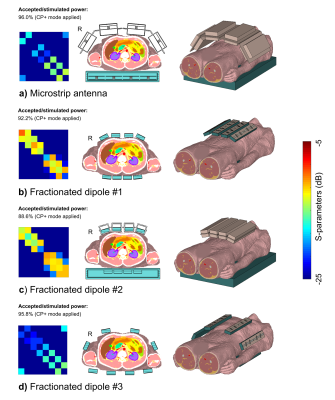 |
Body imaging at 7T: Comparison of the transmit/receive performance of microstrip antennas and fractionated dipoles
Jonathan K. Stelter1, Andreas K. Bitz1,2, Mark E. Ladd1,3,4, and Thomas M. Fiedler1
1Medical Physics in Radiology, German Cancer Research Center (DKFZ), Heidelberg, Germany, 2Electromagnetic Theory and Applied Mathematics, Faculty of Electrical Engineering and Information Technology, FH Aachen – University of Applied Sciences, Aachen, Germany, 3Erwin L. Hahn Institute for MRI, University Duisburg-Essen, Essen, Germany, 4Faculty of Physics and Astronomy and Faculty of Medicine, University of Heidelberg, Heidelberg, Germany
The transmit and receive performance of 8-channel array configurations of microstrip antennas with meander structures and fractionated dipoles was evaluated at 7T using numerical simulations. Simulations with a homogenous phantom and an anatomical body model use similar parameters to facilitate direct comparison. The microstrip antenna array configuration provides higher SNR than the fractionated dipole array configurations and shows superior RF shimming performance for large-FOV transverse and coronal slices, whereas single-element simulations estimate similar SAR efficiencies. The RF shimming performance of the array configurations does not differ significantly for smaller ROIs as evaluated for prostate imaging.
|
|
4284.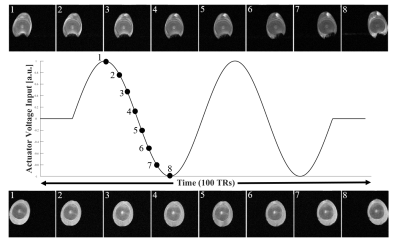 |
Line scan-based dynamic imaging of fluid motion periodically driven by MR actuator
Hankyeol Lee1, Jeongtaek Lee1,2, Jang-Yeon Park1,2, and Seung-Kyun Lee1,2,3
1Center for Neuroscience Imaging Research, Institute for Basic Science, Suwon, Republic of Korea, 2Dept. of Biomedical Engineering, Sungkyunkwan University, Suwon, Korea, Republic of, 3Dept. of Physics, Sungkyunkwan University, Suwon, Korea, Republic of
Imaging fluid motion in MRI is possible with high temporal resolution and reliable motion-inducing mechanism. In this study, line-scanning with 5.5 ms temporal resolution was used to image fluid motion inside quail eggs which were periodically driven by an MR actuator. Resulting time-course images captured accurate displacements of the eggs and the internal fluid motion over time.
|
|
4285. |
Investigation of appropriate frequency band and antenna for non-contact monitoring of heart and respiration rate
Takafumi Ohishi1
1Advanced Technology Department, Research and Development Center, Canon Medical Systems Corporation, Kawasaki, Japan
This paper investigates the appropriate frequency band and antenna used for a non-contact heart and respiratory rate monitoring system applying an antenna. As a result of measurements with different resonant frequency antennas, it is found that the appropriate frequency band is around 600 MHz. Furthermore, an antenna having multi resonance elements reduces the influence of abdominal motion in breathing at detecting heart rate.
|
|
4286.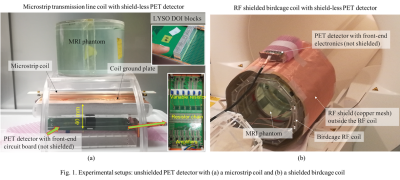 |
Feasibility study of unshielded PET detectors with shielded RF coil for PET/MRI insert
Md Shahadat Hossain Akram1, Takayuki Obata2, Fumihiko Nishikido1, and Taiga Yamaya1
1Advance Nuclear Medicine Sciences, National Institute of Radiological Sciences (NIRS-QST), Chiba, Japan, 2Molecular Imaging and Theranostics, National Institute of Radiological Sciences (NIRS-QST), Chiba, Japan
We used shielded RF coil in combination with unshielded PET detector. A microstrip coil and a head-size birdcage coil was used. For microstrip coil, the ground conductor acted as the shield, while for the birdcage coil a cylindrical RF shield was implemented. A PET detector with front-end electronics was implemented 40 mm far from the RF shields. Phantom studies revealed no RF pickup noise in any of these cases. A maximum 16% reduction in SNR was seen for the microstrip coil between PET detector powered OFF and ON conditions. However, the SNR reduction for the birdcage coil was negligible.
|
|
4287.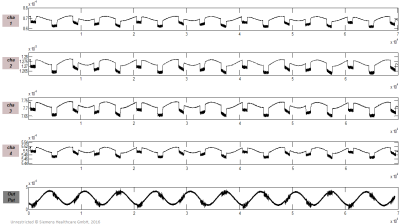 |
A Component Projection Algorithm for eliminating the interference of Pilot Tone Signal
Qiong Zhang1, Yong Xiao Zhang2, and Yulong Liu3
1DL, Siemens, Shenzhen, China, 2MR Collaborations, Siemens Healthcare Ltd., Shenzhen, China, 3Beijing Institute of Technology, BeiJing, China In this work, we provided a component-projection algorithm for Pilot Tone (PT) signal anti-jamming. The interference of a PT signal induced by the MR measurement can be effectively mitigated with the following procedure: the original PT signals received by the array coil are orthogonally transformed into the Eigen Space of interference signal, and the principle component of interference Eigen Space is subsequently discarded to maximally suppress the interference before the remaining components are projected into a predefined direction to combine the final PT navigator signal. Phantom and volunteer experiments demonstrated that the technique can effectively reduce the interference during scanning. |
|
4288.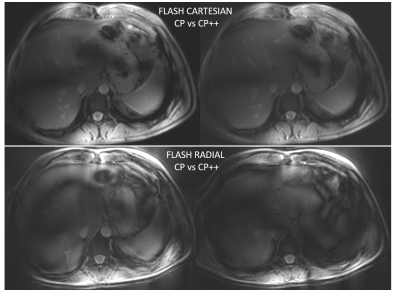 |
Initial experience on 7T Terra for human parallel transmit (pTx) liver imaging
Saba Shirvani*1, Belinda Ding*1, Iulius Dragonu2, Patrick Liebig3, Catarina Rua1, Jabrane Karkouri1, Dennis Klomp4, Aaron T. Hess5, and Christopher T. Rodgers1
1Wolfson Brain Imaging Centre, Department of Clinical Neurosciences, University of Cambridge, Cambridge, United Kingdom, 2Siemens Healthcare Ltd, Research and Collaboration UK, Frimley, United Kingdom, 3Siemens Healthcare Limited, Erlangen, Germany, 4UMC Utrecht, Utrecht, Netherlands, 5Oxford Centre for Magnetic Resonance, University of Oxford, Oxford, United Kingdom
Abdominal 7T MRI is technically demanding, but has great potential due to the improved signal-to-noise-ratio and altered image contrast. We describe our initial experience of abdominal imaging on a 7T Terra scanner (Siemens), using an 8-channel TEM coil that was previously used on a Magnetom 7T scanner. First, we describe how we adapted the RF power limits from the VB17 format to the VE12U format, including an experimental validation. Then, we show our first human in vivo liver images from the 7T Terra, including B0 and B1+ maps, and FLASH images (radial and Cartesian), for two RF shim settings.
|
|
4289.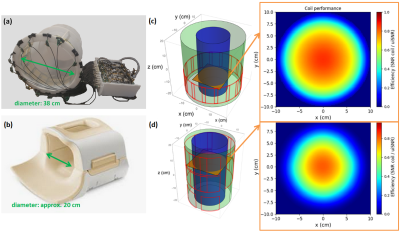 |
Invisible receiver arrays? Proof of effective long distance RF arrays when tissue loss dominates
Kyung Min Nam1, Cezar Alborahal1, Kaizad Rustomji2, Tryfon Antonakakis3, Catalina Arteaga de Castro4, Jannie P. Wijnen1, and Dennis W.J. Klomp1
1Imaging and Oncology, UMC Utrecht, Utrecht, Netherlands, 2Multiwave Innovation, Marseille, France, 3Multiwave Innovation, Geneva, Switzerland, 4Tesla Dynamic Coils, Zaltbommel, Netherlands
High-quality MRI uses arrays of local receiver coils positioned close to the region of interest to maximize acceleration performance and SNR in the images. This comes at the expense of patient comfort, particularly when considering surgical interventions under close to real-time MRI guidance. Here we demonstrate that when the tissue dominates the noise source over the electronic noise, the distance of the coil array to the tissue can be increased beyond the head to the bore liner of a head MR system without substantially decreasing the acceleration performance and intrinsic signal to noise compared to commercially available head coils.
|
|
4290.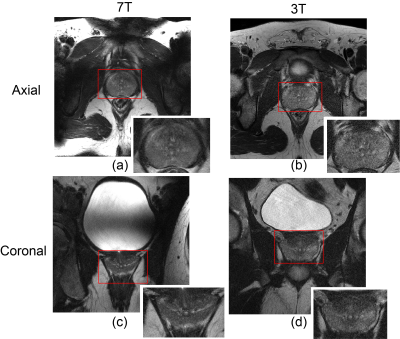 |
A Comparative Study on High Resolution Prostate Imaging at 7T and 3T MRI
Mingyan Li1, Aurelien Destruel1, Ewald Weber1, Aiman Al-Najjar2, Shekhar Chandra1, Feng Liu1, Craig Engstrom3, and Stuart Crozier1
1School of Information Technology and Electrical Engineering, The University of Queensland, Brisbane, Australia, 2Centre for Advanced Imaging, The University of Queensland, Brisbane, Australia, 3School of Human Movement and Nutrition Sciences, The University of Queensland, Brisbane, Australia
High-resolution prostate imaging for both 3T and 7T MRI are challenging, given the deep location of this exocrine gland which accentuates technical issues related to the reduced electromagnetic penetration and B1 inhomogeneity. In this work, high-resolution (0.3 x 0.3mm in-plane) non-interpolated T2w-TSE prostate images from a healthy volunteer were acquired at 3T using a commercial 18-channel body matrix and 32-channel spine coil and an 8-channel prototype coil at 7T at 15 slices and 11 slices, respectively. Compared with standard clinical prostate imaging at 3T, the 7T prostate images provided higher SNR and better differentiation of various zones of the prostate.
|
|
4291.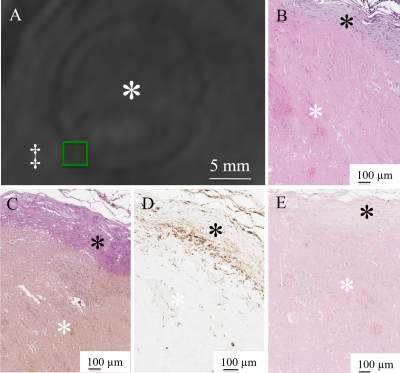 |
Relationship between thrombus and aneurysm wall in partially thrombosed intracranial aneurysms visualized with 7T MPRAGE
Bixia Chen1,2, Taku Sato2,3, Oliver Gembruch1,2, Michael Forsting4, Alexander Radbruch4, Jan Rodemerk2, Shiqing He2, Stefan Maderwald1, Harald H. Quick1,5, Mark E. Ladd1,6, Ulrich Sure2, and Karsten H. Wrede1,2
1Erwin L. Hahn Institute for Magnetic Resonance Imaging, University Duisburg-Essen, Essen, Germany, 2Department of Neurosurgery, University Hospital Essen, University Duisburg-Essen, Essen, Germany, 3Department of Neurosurgery, Fukushima Medical University, Fukushima, Japan, 4Department of Diagnostic and Interventional Radiology and Neuroradiology, University Hospital Essen, University Duisburg-Essen, Essen, Germany, 5High Field and Hybrid MR Imaging, University Hospital Essen, University Duisburg-Essen, Essen, Germany, 6Medical Physics in Radiology, German Cancer Research Center (DKFZ), Heidelberg, Germany
This in-vivo study aimed to investigate the relationship between thrombus characteristics and the aneurysm wall (AW) in partially thrombosed intracranial aneurysms (pTIAs) using MPRAGE at 7T MRI. The AWs with the highest signal intensity ratio of thrombus were significantly thicker. In the histopathological examinations, three cases with hypointensity of the thrombus showed only a few macrophages in the thrombus and a thin AW. Three cases with hyperintensity of the thrombus in the MPRAGE showed abundant macrophages in the thrombus. In 7T MPRAGE, the signal intensity ratio of thrombus in pTIAs correlates with AW thickness and histologic features indicating wall instability.
|
|
4292.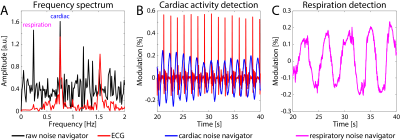 |
Measuring cardiac activity with a thermal noise based self-navigator
Robin Navest1,2, Stefano Mandija1,2, Stefan Zijlema1,2, Luca van Dijk1, Bjorn Stemkens1, Jan Lagendijk1, Anna Andreychenko1,3, and Cornelis van den Berg1,2
1Radiotherapy, UMC Utrecht, Utrecht, Netherlands, 2Computational Imaging Group for MRI Diagnostics & Therapy, Center for Image Sciences, UMC Utrecht, Utrecht, Netherlands, 3Research and Practical Clinical Center of Diagnostics and Telemedicine Technologies of the Moscow Department of Healthcare, Moscow, Russian Federation
The ECG signal can be disturbed by the magnetohydrodynamic effect and requires placement of ECG electrodes. The latter adds extra workload in the patient setup. Moreover, for MRI-guided radiotherapy, ECG skin electrodes will interfere with dose delivery and thus cannot be used. We propose to use the noise navigator, a passive self-navigation method based on the physiological motion-induced modulation of the thermal noise variance measured by an RF receive coil, which does not require additional hardware and is inherently synchronized with MR acquisition.
|
|
4293.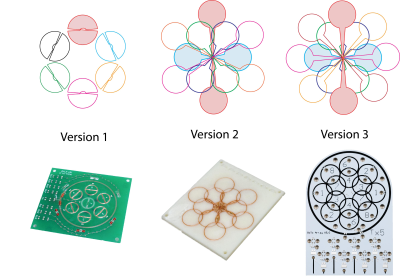 |
Design considerations for short-wave motion tracking
Christoph Michael Schildknecht1, David Otto Brunner1, Thomas Schmid1, and Klaas Paul Pruessmann1
1Institute for Biomedical Engineering, ETH Zurich and University of Zurich, Zurich, Switzerland
RF short-wave based motion tracking offers interesting prospects by allowing to localize markers without line of site, minimal interaction with the MRI scanner, very short latency and high precision. The design of the employed antenna arrays is however determinant for the performance of the entire system and subject to various requirements. The design criteria and parameters have hence been analyzed and used for optimization of the receiver array geometry. The resulting arrays have then been evaluated using signal simulations as well implemented and verified by bench measurements using a robotic positioning system as reference.
|
|
4294.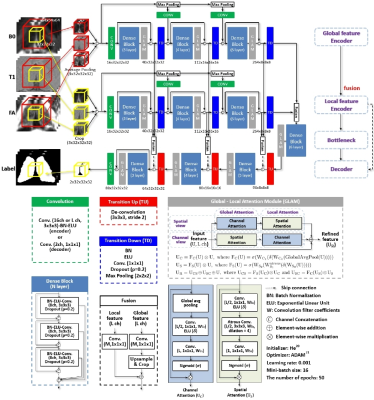 |
A Context-Aware Deep Attention Network for Thalamus Segmentation using 7T Multi-Modal MRI
Jinyoung Kim1, Rémi Patriat1, Oren Rosenberg1, and Noam Harel1
1Center for Magnetic Resonance Research, University of Minnesota, Minneapolis, MN, United States
In this study, we leverage 7T MR multi-modality and deep neural networks for accurate and efficient segmentation of the thalamus. Our contributions are 1) to build a dual-pathway and feature pyramid scheme to simultaneously encode global contextual information and local details within an encoder-decoder network; 2) to learn the optimal combination of global and local attentions to increase the feature representation power by adaptively recalibrating feature maps in an end-to-end manner. The proposed framework shows state-of-the-art performance on segmentation of the thalamus with 7T multi-modal MRI in an automatic and efficient way.
|
|
4295.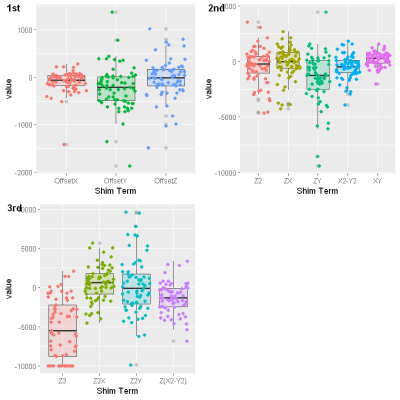 |
On the way to routine cardiac MRI at 7Tesla- using what we have
Theresa Reiter1,2, David Lohr2, Michael Hock2, Markus Johannes Ankenbrand2, Maria Roxana Stefanescu2, Maxim Terekhov2, and Laura Maria Schreiber2
1Department of Internal Medicine, University Hospital Wuerzburg, Wuerzburg, Germany, 2Chair of Cellular and Molecular Imaging, Comprehensive Heart Failure Centre (CHCF), University Hospital Wuerzburg, Wuerzburg, Germany
The establishment of human cardiac MRI in the setting of ultra highfield MRI puts high demands on hardware, sequences and handling of the examinees. Practical and safety relevant limitations are set for extensive modifications regarding hardware and sequence. As a consequence, human based factors play a paramount role in the success of a routinely used cardiac imaging study at 7T. We report our experiences from 71 volunteers with cardiac MRI scans with the aim to increase the understanding of the practical implementation of cardiac MRI and factors that influence and do not influence image quality in this specific setting.
|
|
4296.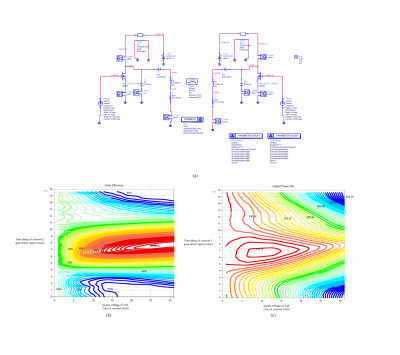 |
Optimizing Efficiency of Coupled Class-E RF Amplifiers for a Transmit Array System in 1.5 T
Said Aldemir1, Fatima tu Zahra2, Redi Poni3, and Ergin Atalar4
1Electrical and Electronics Engineering, Bilkent University, Ankara, Turkey, 2-, Ankara, Turkey, 3ETH Zurich, Zurich, Sweden, 4Electrical Electronics Engineering, Bilkent University, Ankara, Turkey
In this work, performance of coupled Class-E amplifiers in a transmit array system is investigated. Conditions for these nonlinear amplifiers to work efficiently with desired output power are determined. Also a tuning procedure mitigating undesired effects of coupling on the performance of these nonlinear amplifiers is explained. Simulations are performed in ADS 2016 with 2 Class-E amplifiers and different coupling levels are tested. MRI experiment is performed in order to observe the effects of coupling on amplifier performance. With contour plots, how overall performance of the system is affected by phase and amplitude of an amplifier channel is investigated.
|

 Back to Program-at-a-Glance
Back to Program-at-a-Glance View the Poster
View the Poster Watch the Video
Watch the Video Back to Top
Back to Top